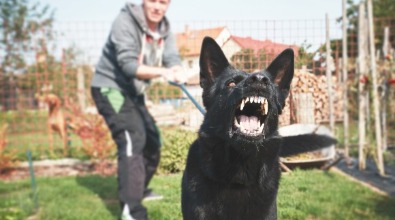Anyone who has ever owned a dog knows how frustrating the training process can be. It’s tedious and repetitive, and some dogs don’t pick lessons up as quickly as we would like them to. So what do you do when your dog has another accident inside the house or doesn’t “sit” instantly after you’ve commanded them to several times? Some people believe that these situations call for a method known as “aversive training.”
What is “aversive training”?
Aversive training is the practice of using punishment to suppress or diminish unwanted behaviors in an animal. Typically, people who use these methods believe that owners need to physically assert themselves over their pets and assume the position of “alpha dog.”
“The most common aversives used in dog training include physical corrections via prong or choke collars, shock or spray corrections from electric collars, alpha rolls, and dominance downs, shaker cans, spray bottles, yelling, hitting, confrontational staring or acting in a threatening manner towards the dog.” – Cathy Madson, MA, CBCC-KA, CPDT-KA
While animal psychologists and certified trainers alike have widely debunked this theory, some people still believe it is the best and only way to train an animal. To help prevent this practice from spreading, we have dedicated this post to outline the issues and subsequent dangers of using aversive training.
Dangers of Using “Aversive Training”
It’s Painful and Inhumane
If you Google aversive training, some of the first things that pop up are the trade tools. These will include choke collars, prong collars, and shock collars. These apparatuses were all designed to inflict pain and discomfort on an animal. They have been widely used because of the idea that dogs have thicker skin than humans and are not as sensitive to pain. This is an unfortunate misconception. Not only are dogs as equally sensitive to pain as humans are, but their skin is also thinner and easier to damage around the neck area.
Additionally, these aversive training collars are easy to misuse. The choke and prong collars are designed to tighten around a dog’s neck when the leash they are attached to is pulled.
There is no way to control how tight the collar gets, so unless an owner is paying very close attention, they can easily strangle their pet.
What if a dog’s choke collar gets snagged on something and tightens? What will happen if something spooks or startles your dog while on a walk, and they suddenly bolt? These are just a couple of possible situations that could occur when using an aversive collar that can lead to your pet suffering esophageal damage, torn muscles, and even death by strangulation.
What if a dog’s choke collar gets snagged on something and tightens? What will happen if something spooks or startles your dog while on a walk, and they suddenly bolt? These are just a couple of possible situations that could occur when using an aversive collar that can lead to your pet suffering esophageal damage, torn muscles, and even death by strangulation.

It Can Make Your Dog Even More Aggressive
A study done by the University of Pennsylvania found that training animals using aversive methods resulted in them being 25% more likely to react aggressively to their owners. They also found that these dogs were much more likely to respond aggressively to new situations than dogs who were not trained with aversive techniques.

Here are some other not-so-surprising statistics the study found on the dogs who were trained aversively:
- 43% of dogs responded with aggression to being hit or kicked
- 38% of dogs responded with aggression to having an owner grab their mouth and take out an object forcefully
- 36% of dogs responded with aggression to having a muzzle put on their face
- 29% of dogs responded with aggression to a “dominance down.”
- 26% of dogs responded with aggression to a jowl or scruff shake
The Dog Can Develop a Punishment Callous
A punishment callous is when animals (including humans) develop a tolerance for a negative stimulus. Once that tolerance has been established, the negative stimulus no longer works as a method to stop unwanted behavior. Unfortunately, when a dog builds up a callous during aversive training, the human will increase the frequency or severity of the punishment.
In a study done by N. E. Miller, 100 hungry rats were trained to run down an alley toward food. One-third of the rats would receive an electric shock when they approached their goal, and the other two-thirds were introduced to the shock over some time, with the intensity of the shock slowly increasing. The purpose of this practice was to induce an approach-avoidance conflict.
However, the results of the study came to the following conclusions:
- Animals learn to tolerate the intensity of an ever-increasing aversive.
- Animals become shut-down and can’t learn when aversives are used.

It Doesn’t Work!
Trainers and pet owners who use aversive methods focus so much of their time telling their dog what not to do that they forget to teach them what they should do! Imagine if you are an employee at a company, and every time you do something wrong, you are yelled at. It will take you a long time to figure out what your boss wants you to do, and you will probably become frustrated and resentful.
Stress caused by negative training can actually decrease a dog’s ability to learn. According to two scientific studies (Joels et al. 2006; Mendl, 1999 and Walker et al.,1997), when a dog experiences higher or more chronic levels of stress, their ability to learn is inhibited. This is mainly because their brain focuses on the fear they are experiencing and is unable to consolidate and retrieve memories.
A very recent study, Efficacy of Dog Training With and Without Remote Electronic Collars vs. a Focus on Positive Reinforcement, found that “These findings refute the suggestion that training with an E-collar is either more efficient or results in less disobedience, even in the hands of experienced trainers. In many ways, training with positive reinforcement was found to be more effective at addressing the target behavior as well as general obedience training. This method of training also poses fewer risks to dog welfare and the quality of the human-dog relationship. Given these results, we suggest that there is no evidence to indicate that E-collar training is necessary, even for its most widely cited indication.”

They Ruin the Human-Dog Bond
You think your dog will love you, no matter what. But in actuality, aversive techniques put your relationship with your dog at risk. If you are creating a more fearful dog, he or she will be afraid to relax around you and will not be a happy pet. If there are other training options available, why would anyone choose methods that can hurt their best friend?
Final Thoughts:
You have to ask yourself whether you want a fearful pup or a confident one. You have to ask yourself what you want our of your relationship with your dog. Do you want them to be afraid and resentful of you? Or are you looking for a life-long companion to nurture? The fact of the matter is aversive training is a method built on fear. It is not the basis for a trusting and fulfilling relationship with your dog.
Special thanks to:

Drayton Michaels, CTC
Drayton Michaels, CTC is the owner of Urban Dawgs Dog Training in Red Banks, NJ. He also holds a Certification in Dog Training and Behavior Counseling from the San Francisco SPCA Academy for Dog Trainers.





